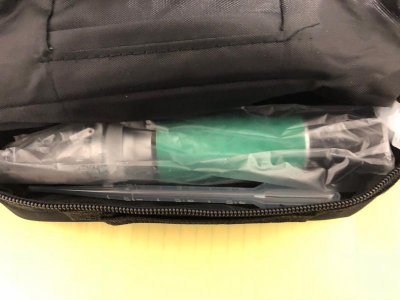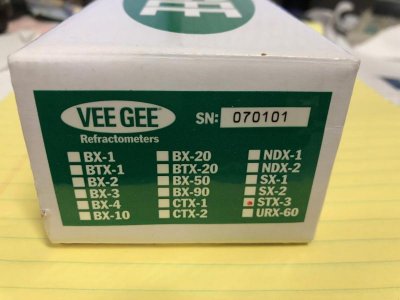slief
RC Sponsor
Up for sale is a brand new in the box Vee Gee STX-3. This is a professional/lab grade refractometer. Nothing like the cheap ones. These hold their calibration well and have a full salinity scale. Asking $110 for it. PM Me if you are interested.
Specs are:
Handheld portable refractometer for measurement of salt concentration in parts per thousand (PPT) (0 to 100%) and specific gravity (SG) (1.000 to 1.070) of seawater in the 10 to 30 degrees C temperature range
Automatic temperature compensation (ATC) for immediate and accurate calibration readings, regardless of ambient temperature
Ambient light illuminates the scale; no additional power source is required
Durable metal and rubber outer shell with a telescope-shaped, streamlined design (40 x 40 x 185mm), a rubber grip to guard against hand heat for accurate measurements, and a non-roll stand to protect against damage
Optical glass prism mounted in all-metal housing for quick temperature equilibrium between sample and prism
Product description
The VEE GEE STX-3 is a handheld, portable, water-resistant salinity refractometer that measures salt concentration in parts per thousand (PPT) in the 0 to 100% range and specific gravity (SG) of seawater in the 1.000 to 1.070 range, has automatic temperature compensation (ATC), and a durable metal body with rubber grip. A salinity refractometer measures the concentration of salt, such as sodium chloride, magnesium and calcium sulfates, in liquids and displays the results. Handheld refractometers, also known as sugar meters, concentration meters, or Brix meters, are commonly used in the culinary, food and beverage, pharmaceutical, educational, geological, chemical, and ecological industries, and for water-testing applications.
This refractometer is housed in a durable metal body. The VEE GEE STX-3 features ATC for immediate, accurate readings, with an ambient temperature of 10 to 30 degrees C. The unit is factory-calibrated and can be calibrated with distilled water. Calibration can be controlled and adjusted with a tool-free calibration ring and a set screw. The outer shell is rubber coated with dimpled grip for easy gripping and the rubber coating guards against hand heat for accurate measurements. A non-roll stand prevents the unit from rolling when placed on a flat surface such as a table or bench top. The optical glass prism is mounted in an all-metal housing composed of copper alloy with a nickel-chrome coating for quick temperature equilibrium between the sample and the prism. The analog Brix scale features a bright, high-contrast display for clear visibility of the boundary and memory lines intersection. Instantaneous sample readings illuminated by ambient light are viewed through a monocular, focusable, cushioned eyepiece. The unit comes with a zippered vinyl carrying case, a plastic transfer pipet and an instruction manual.
Specifications
Measurement scale range Salinity (PPT) 0 to 100%, Seawater (SG) 1.000 to 1.070
Specimen measurement temperature range 10 to 30 degrees C
Accuracy Salinity + or "“ 1.0%, Seawater (SG) + or "“ 0.001, Temperature + or - 1 degrees C
Resolution Salinity 1.0%, Seawater (SG) 0.001, Temperature 1 degrees C
Ambient temperature for unit operation 10 to 30 degrees C
Sample volume > 0.1ml
Measurement time Instantaneous
Body type Copper alloy with a nickel-chrome coating
Illumination Ambient light; unit requires no additional power source
Dimensions 40 x 40 x 185mm (H x W x D)
Weight 285g
Warranty One year
H is height, the vertical distance from the lowest to highest point; W is width, the horizontal distance from left to right; D is depth, the horizontal distance from front to back.
Refractometers are used to determine substance content in a sample, to provide unit readings of substances including Brix, salinity, and alcohol; to detect chemical impurities, or to measure components of samples such as industrial fluid. Refractometers measure the refractive index of a substance, which is its optical characteristic, and the number of dissolved particles in it. The refractive index is the ratio of the speed of light in empty space to the speed of light in a substance; when light passes from one medium to another. Generally, a low concentration sample has a larger angle of refraction than a high concentration sample. For example, a straw placed in a high-concentration substance appears more bent than when placed in a low-concentration substance. Refractometers can work with natural light, or with an external power source such as batteries or electricity. They typically have either a digital or analog reading display, though some units utilize both types. Some analog-display refractometers can be used for both solids and liquids. Digital-display refractometers are used exclusively for liquids. Types of refractometers include handheld, benchtop, and in-process. Handheld refractometers are elongated and telescope-shaped, or shorter and rectangular. Analog handheld refractometer readings are obtained by looking through the monocular eyepiece and viewing where the boundary line intersects with the memory line. Digital handheld models provide a digital readout. Benchtop refractometers typically measure with a higher degree of accuracy than handheld units. In-process refractometers are used for continuous process monitoring and data readouts, and are generally fitted into a piping system for ongoing analysis. Refractometers are used in a wide variety of applications in the culinary, food and beverage, pharmaceutical, educational, geological, chemical, ecological, and automotive industries, and for water-testing applications.
VEE GEE Scientific manufactures laboratory equipment and supplies, and makes the VanGuard brand of products. The company, founded in 1981 and headquartered in Kirkland, WA, offers scientific equipment for educational, research, clinical, and industrial applications.
What's in the Box?
STX-3 refractometer
Vinyl carrying case
Plastic transfer pipet
Instructions
Specs are:
Handheld portable refractometer for measurement of salt concentration in parts per thousand (PPT) (0 to 100%) and specific gravity (SG) (1.000 to 1.070) of seawater in the 10 to 30 degrees C temperature range
Automatic temperature compensation (ATC) for immediate and accurate calibration readings, regardless of ambient temperature
Ambient light illuminates the scale; no additional power source is required
Durable metal and rubber outer shell with a telescope-shaped, streamlined design (40 x 40 x 185mm), a rubber grip to guard against hand heat for accurate measurements, and a non-roll stand to protect against damage
Optical glass prism mounted in all-metal housing for quick temperature equilibrium between sample and prism
Product description
The VEE GEE STX-3 is a handheld, portable, water-resistant salinity refractometer that measures salt concentration in parts per thousand (PPT) in the 0 to 100% range and specific gravity (SG) of seawater in the 1.000 to 1.070 range, has automatic temperature compensation (ATC), and a durable metal body with rubber grip. A salinity refractometer measures the concentration of salt, such as sodium chloride, magnesium and calcium sulfates, in liquids and displays the results. Handheld refractometers, also known as sugar meters, concentration meters, or Brix meters, are commonly used in the culinary, food and beverage, pharmaceutical, educational, geological, chemical, and ecological industries, and for water-testing applications.
This refractometer is housed in a durable metal body. The VEE GEE STX-3 features ATC for immediate, accurate readings, with an ambient temperature of 10 to 30 degrees C. The unit is factory-calibrated and can be calibrated with distilled water. Calibration can be controlled and adjusted with a tool-free calibration ring and a set screw. The outer shell is rubber coated with dimpled grip for easy gripping and the rubber coating guards against hand heat for accurate measurements. A non-roll stand prevents the unit from rolling when placed on a flat surface such as a table or bench top. The optical glass prism is mounted in an all-metal housing composed of copper alloy with a nickel-chrome coating for quick temperature equilibrium between the sample and the prism. The analog Brix scale features a bright, high-contrast display for clear visibility of the boundary and memory lines intersection. Instantaneous sample readings illuminated by ambient light are viewed through a monocular, focusable, cushioned eyepiece. The unit comes with a zippered vinyl carrying case, a plastic transfer pipet and an instruction manual.
Specifications
Measurement scale range Salinity (PPT) 0 to 100%, Seawater (SG) 1.000 to 1.070
Specimen measurement temperature range 10 to 30 degrees C
Accuracy Salinity + or "“ 1.0%, Seawater (SG) + or "“ 0.001, Temperature + or - 1 degrees C
Resolution Salinity 1.0%, Seawater (SG) 0.001, Temperature 1 degrees C
Ambient temperature for unit operation 10 to 30 degrees C
Sample volume > 0.1ml
Measurement time Instantaneous
Body type Copper alloy with a nickel-chrome coating
Illumination Ambient light; unit requires no additional power source
Dimensions 40 x 40 x 185mm (H x W x D)
Weight 285g
Warranty One year
H is height, the vertical distance from the lowest to highest point; W is width, the horizontal distance from left to right; D is depth, the horizontal distance from front to back.
Refractometers are used to determine substance content in a sample, to provide unit readings of substances including Brix, salinity, and alcohol; to detect chemical impurities, or to measure components of samples such as industrial fluid. Refractometers measure the refractive index of a substance, which is its optical characteristic, and the number of dissolved particles in it. The refractive index is the ratio of the speed of light in empty space to the speed of light in a substance; when light passes from one medium to another. Generally, a low concentration sample has a larger angle of refraction than a high concentration sample. For example, a straw placed in a high-concentration substance appears more bent than when placed in a low-concentration substance. Refractometers can work with natural light, or with an external power source such as batteries or electricity. They typically have either a digital or analog reading display, though some units utilize both types. Some analog-display refractometers can be used for both solids and liquids. Digital-display refractometers are used exclusively for liquids. Types of refractometers include handheld, benchtop, and in-process. Handheld refractometers are elongated and telescope-shaped, or shorter and rectangular. Analog handheld refractometer readings are obtained by looking through the monocular eyepiece and viewing where the boundary line intersects with the memory line. Digital handheld models provide a digital readout. Benchtop refractometers typically measure with a higher degree of accuracy than handheld units. In-process refractometers are used for continuous process monitoring and data readouts, and are generally fitted into a piping system for ongoing analysis. Refractometers are used in a wide variety of applications in the culinary, food and beverage, pharmaceutical, educational, geological, chemical, ecological, and automotive industries, and for water-testing applications.
VEE GEE Scientific manufactures laboratory equipment and supplies, and makes the VanGuard brand of products. The company, founded in 1981 and headquartered in Kirkland, WA, offers scientific equipment for educational, research, clinical, and industrial applications.
What's in the Box?
STX-3 refractometer
Vinyl carrying case
Plastic transfer pipet
Instructions


